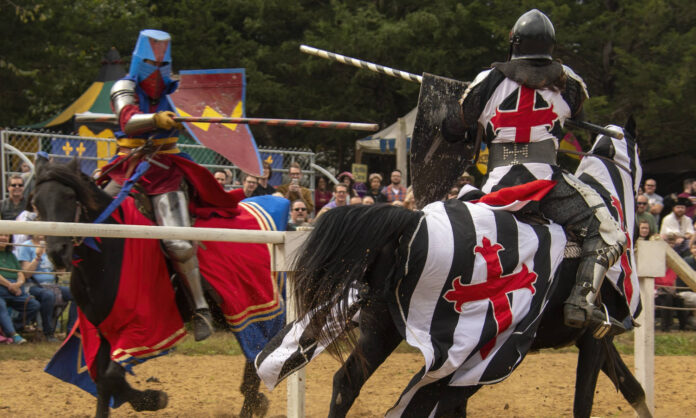
In another article in her series for Writer’s Digest, Carla Hoch offers advice for writing jousting scenes. “Jousting was a common part of tournaments which were a significant part of medieval culture,” she writes. “These sanctioned fights allowed viewers a glimpse of the glory of battle from a safe seat. The joust, in particular, because of the size of the horse, the shine of the armor, and sound of the impact, was a spectacle that drew crowds.”
Jousting was only one of many melee games played at a tournament, but one that required special equipment besides the horse you rode in on.
- Attire. Heavier and less flexible than field armor, jousting armor was twice the weight and had multiple elements not needed on a battlefield, such as a large pauldron, which protected the upper shoulder and chest from an opponent’s lance. Jousting armor also included a gorget to protect the neck and collarbone, as well as a helmet that covered more of the face. Although lances used in tournaments were made of wood, they could still prove deadly.
- Technique. “The lance was to be grasped in the right hand with the palm and thumb pointing up,” Hoch explains. “This hand position protected the wrist. The remaining length of the handle was tucked tightly under the arm.” The jousters rode with their left sides to each other, lances held on the right and pointed diagonally toward the opponent.
- The Horse. The most popular horse for jousting was the Spanish destrier. “These war horses were tall and strong which made them not only able to carry a heavy rider but do so quickly with a regal appearance,” Hoch writes. “Destriers were also aggressive which made them less likely to shudder at the sound or force of the lance strike.”
- The Dangers. As you might expect, being struck by a lance propelled by the full force of a galloping horse would be painful. “Broken bones, concussions and internal injuries were not uncommon in the sport,” Hoch notes. Overheating and injuries caused by flying splinters were also a threat.











